turn signal SKODA SUPERB 2004 1.G / (B5/3U) User Guide
[x] Cancel search | Manufacturer: SKODA, Model Year: 2004, Model line: SUPERB, Model: SKODA SUPERB 2004 1.G / (B5/3U)Pages: 270
Page 73 of 270
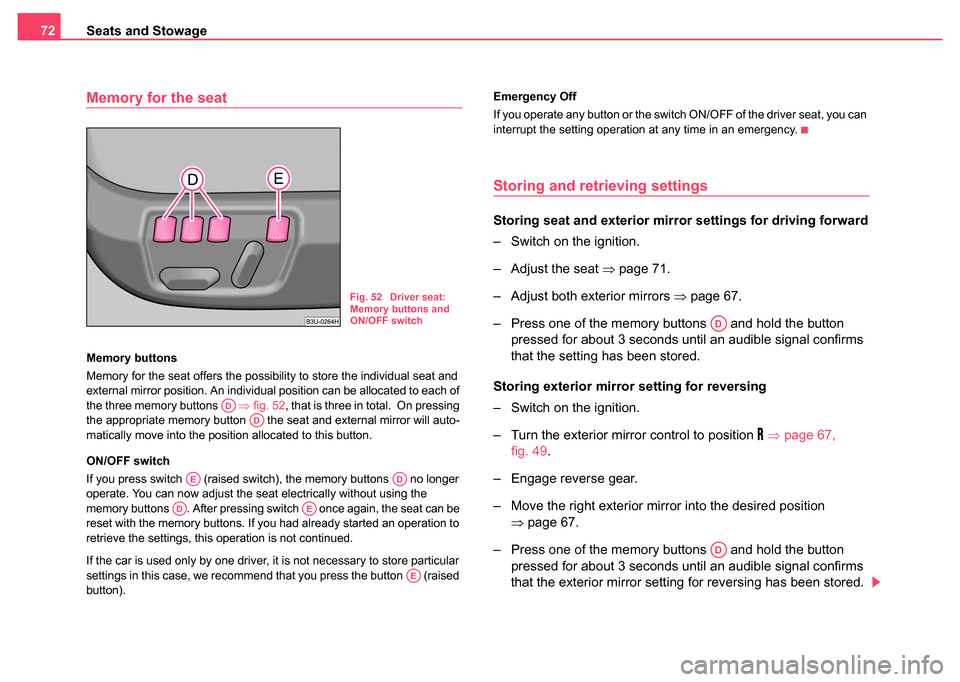
Seats and Stowage
72
Memory for the seat
Memory buttons
Memory for the seat offers the possibility to store the individual seat and
external mirror position. An individual position can be allocated to each of
the three memory buttons ⇒ fig. 52, that is three in total. On pressing
the appropriate memory button the seat and external mirror will auto-
matically move into the position allocated to this button.
ON/OFF switch
If you press switch (raised switch), the memory buttons no longer
operate. You can now adjust the seat electrically without using the
memory buttons . After pressing switch once again, the seat can be
reset with the memory buttons. If you had already started an operation to
retrieve the settings, this operation is not continued.
If the car is used only by one driver, it is not necessary to store particular
settings in this case, we recommend that you press the button (raised
button). Emergency Off
If you operate any button or the switch ON/OFF of the driver seat, you can
interrupt the setting operation at any time in an emergency.
Storing and retrieving settings
Storing seat and exterio
r mirror settings for driving forward
– Switch on the ignition.
– Adjust the seat ⇒page 71.
– Adjust both exterior mirrors ⇒page 67.
– Press one of the memory buttons and hold the button pressed for about 3 seconds until an audible signal confirms
that the setting has been stored.
Storing exterior mirror setting for reversing
– Switch on the ignition.
– Turn the exterior mirror control to position
⇒ page 67,
fig. 49 .
– Engage reverse gear.
– Move the right exterior mirror into the desired position ⇒page 67.
– Press one of the memory buttons and hold the button pressed for about 3 seconds until an audible signal confirms
that the exterior mirror setting for reversing has been stored.
Fig. 52 Driver seat:
Memory buttons and
ON/OFF switch
ADAD
AEAD
ADAE
AE
AD
AD
Page 123 of 270
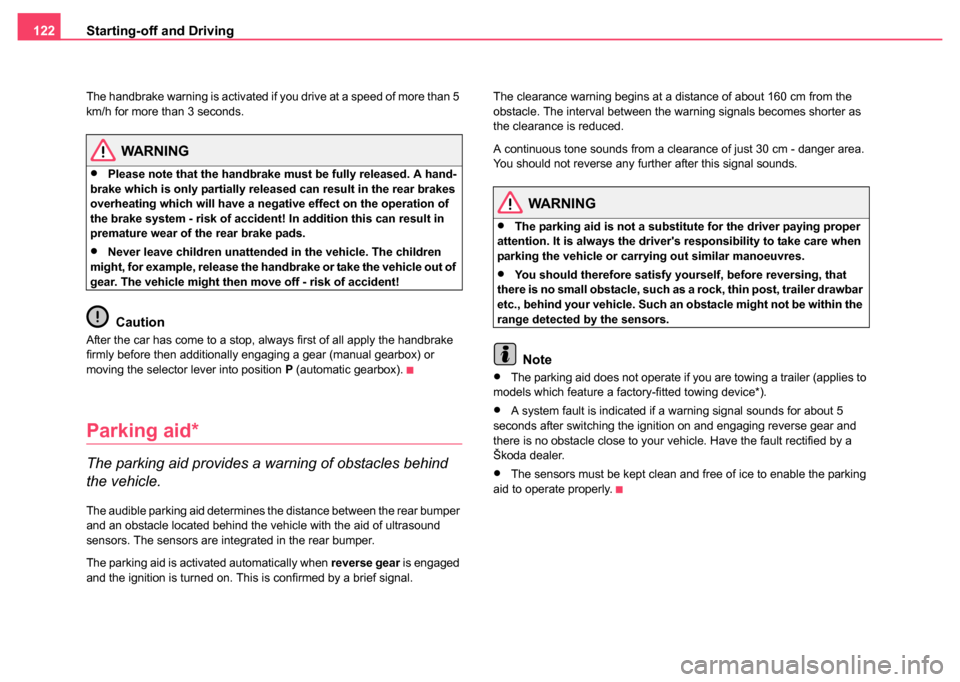
Starting-off and Driving
122
The handbrake warning is activated if you drive at a speed of more than 5
km/h for more than 3 seconds.
WARNING
•Please note that the handbrake must be fully released. A hand-
brake which is only partially released can result in the rear brakes
overheating which will have a negative effect on the operation of
the brake system - risk of accident! In addition this can result in
premature wear of the rear brake pads.
•Never leave children unattended in the vehicle. The children
might, for example, release the handbrake or take the vehicle out of
gear. The vehicle might then move off - risk of accident!
Caution
After the car has come to a stop, always first of all apply the handbrake
firmly before then additionally engaging a gear (manual gearbox) or
moving the selector lever into position P (automatic gearbox).
Parking aid*
The parking aid provides a warning of obstacles behind
the vehicle.
The audible parking aid determines the distance between the rear bumper
and an obstacle located behind the vehicle with the aid of ultrasound
sensors. The sensors are integrated in the rear bumper.
The parking aid is activated automatically when reverse gear is engaged
and the ignition is turned on. This is confirmed by a brief signal. The clearance warning begins at a distance of about 160 cm from the
obstacle. The interval between the warning signals becomes shorter as
the clearance is reduced.
A continuous tone sounds from a clearance of just 30 cm - danger area.
You should not reverse any further after this signal sounds.
WARNING
•The parking aid is not a substitute for the driver paying proper
attention. It is always the driver's responsibility to take care when
parking the vehicle or carrying out similar manoeuvres.
•You should therefore satisfy yourself, before reversing, that
there is no small obstacle, such as a rock, thin post, trailer drawbar
etc., behind your vehicle. Such an obstacle might not be within the
range detected by the sensors.
Note
•The parking aid does not operate if you are towing a trailer (applies to
models which feature a factory-fitted towing device*).
•A system fault is indicated if a warning signal sounds for about 5
seconds after switching the ignition on and engaging reverse gear and
there is no obstacle close to your vehicle. Have the fault rectified by a
Škoda dealer.
•The sensors must be kept clean and free of ice to enable the parking
aid to operate properly.
Page 141 of 270
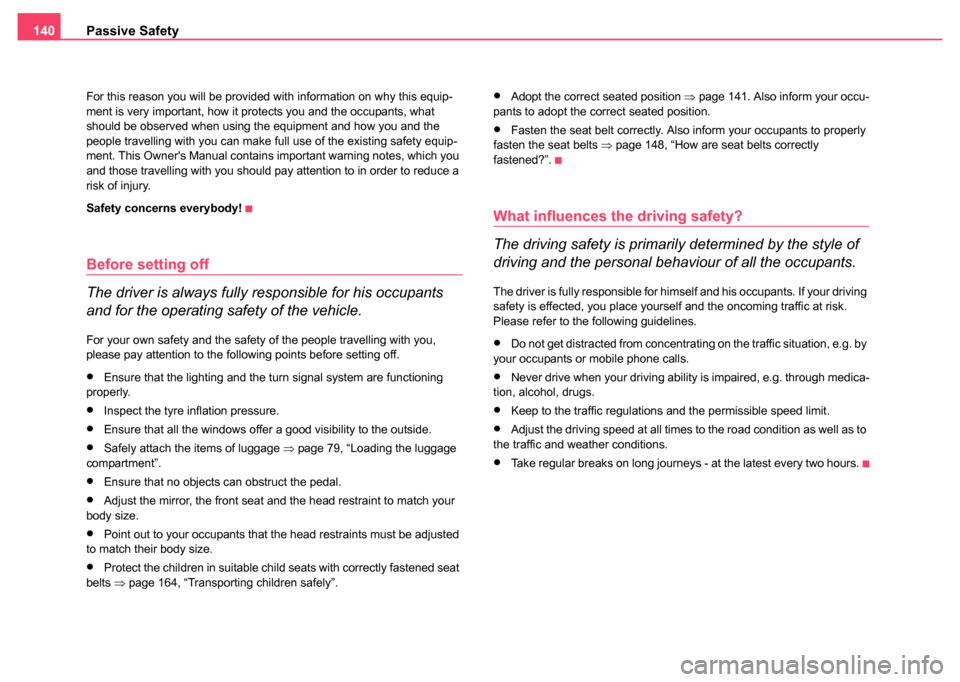
Passive Safety
140
For this reason you will be provided with information on why this equip-
ment is very important, how it protects you and the occupants, what
should be observed when using the equipment and how you and the
people travelling with you can make full use of the existing safety equip-
ment. This Owner's Manual contains important warning notes, which you
and those travelling with you should pay attention to in order to reduce a
risk of injury.
Safety concerns everybody!
Before setting off
The driver is always fully responsible for his occupants
and for the operating safety of the vehicle.
For your own safety and the safety of the people travelling with you,
please pay attention to the following points before setting off.
•Ensure that the lighting and the turn signal system are functioning
properly.
•Inspect the tyre inflation pressure.
•Ensure that all the windows offer a good visibility to the outside.
•Safely attach the items of luggage ⇒page 79, “Loading the luggage
compartment”.
•Ensure that no objects can obstruct the pedal.
•Adjust the mirror, the front seat and the head restraint to match your
body size.
•Point out to your occupants that the head restraints must be adjusted
to match their body size.
•Protect the children in suitable child seats with correctly fastened seat
belts ⇒page 164, “Transporting children safely”.
•Adopt the correct seated position ⇒page 141. Also inform your occu-
pants to adopt the correct seated position.
•Fasten the seat belt correctly. Also inform your occupants to properly
fasten the seat belts ⇒page 148, “How are seat belts correctly
fastened?”.
What influences the driving safety?
The driving safety is primarily determined by the style of
driving and the personal behaviour of all the occupants.
The driver is fully responsible for himself and his occupants. If your driving
safety is effected, you place yourself and the oncoming traffic at risk.
Please refer to the following guidelines.
•Do not get distracted from concentrating on the traffic situation, e.g. by
your occupants or mobile phone calls.
•Never drive when your driving ability is impaired, e.g. through medica-
tion, alcohol, drugs.
•Keep to the traffic regulations and the permissible speed limit.
•Adjust the driving speed at all times to the road condition as well as to
the traffic and weather conditions.
•Take regular breaks on long journeys - at the latest every two hours.
Page 248 of 270
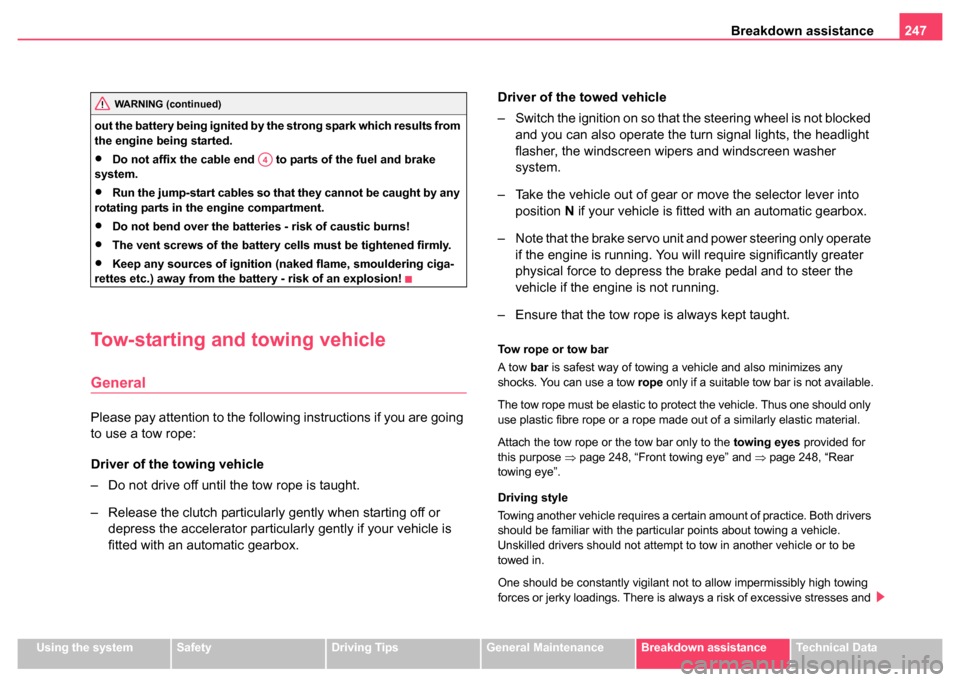
Breakdown assistance247
Using the systemSafetyDriving TipsGeneral MaintenanceBreakdown assistanceTechnical Data
out the battery being ignited by the strong spark which results from
the engine being started.
•Do not affix the cable end to parts of the fuel and brake
system.
•Run the jump-start cables so that they cannot be caught by any
rotating parts in the engine compartment.
•Do not bend over the batteries - risk of caustic burns!
•The vent screws of the battery cells must be tightened firmly.
•Keep any sources of ignition (naked flame, smouldering ciga-
rettes etc.) away from the battery - risk of an explosion!
Tow-starting and towing vehicle
General
Please pay attention to the following instructions if you are going
to use a tow rope:
Driver of the towing vehicle
– Do not drive off until the tow rope is taught.
– Release the clutch particularly gently when starting off or depress the accelerator particularly gently if your vehicle is
fitted with an automatic gearbox. Driver of the towed vehicle
– Switch the ignition on so that the steering wheel is not blocked
and you can also operate the turn signal lights, the headlight
flasher, the windscreen wipers and windscreen washer
system.
– Take the vehicle out of gear or move the selector lever into position N if your vehicle is fitted with an automatic gearbox.
– Note that the brake servo unit and power steering only operate if the engine is running. You will require significantly greater
physical force to depress the brake pedal and to steer the
vehicle if the engine is not running.
– Ensure that the tow rope is always kept taught.
Tow rope or tow bar
A tow bar is safest way of towing a vehicle and also minimizes any
shocks. You can use a tow rope only if a suitable tow bar is not available.
The tow rope must be elastic to protect the vehicle. Thus one should only
use plastic fibre rope or a rope made out of a similarly elastic material.
Attach the tow rope or the tow bar only to the towing eyes provided for
this purpose ⇒page 248, “Front towing eye” and ⇒page 248, “Rear
towing eye”.
Driving style
Towing another vehicle requires a certain amount of practice. Both drivers
should be familiar with the particular points about towing a vehicle.
Unskilled drivers should not attempt to tow in another vehicle or to be
towed in.
One should be constantly vigilant not to allow impermissibly high towing
forces or jerky loadings. There is always a risk of excessive stresses and
WARNING (continued)
A4
Page 252 of 270
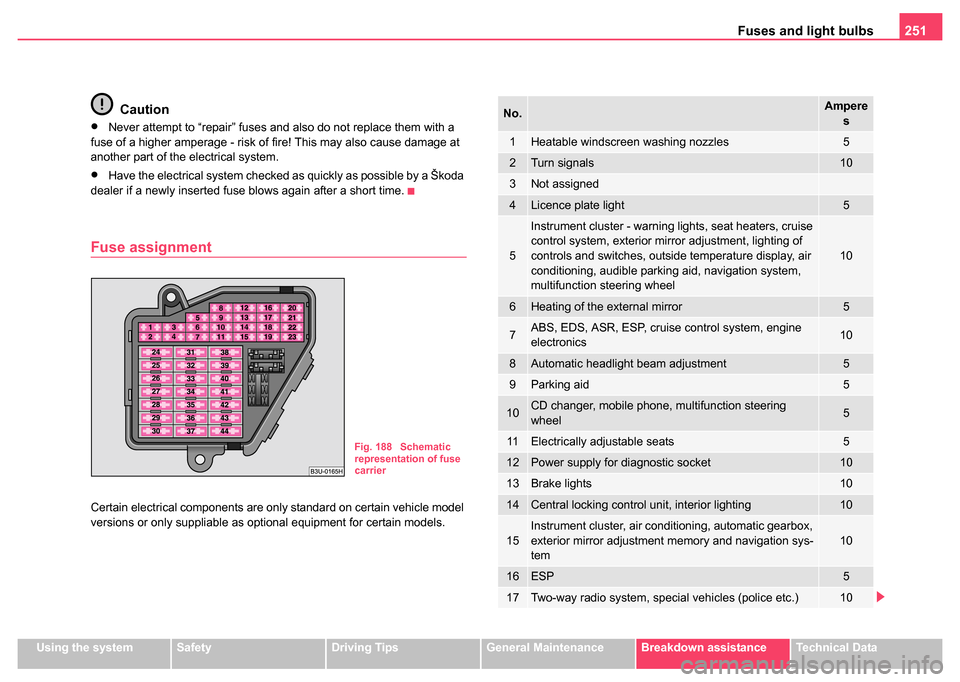
Fuses and light bulbs251
Using the systemSafetyDriving TipsGeneral MaintenanceBreakdown assistanceTechnical Data
Caution
•Never attempt to “repair” fuses and also do not replace them with a
fuse of a higher amperage - risk of fire! This may also cause damage at
another part of the electrical system.
•Have the electrical system checked as quickly as possible by a Škoda
dealer if a newly inserted fuse blows again after a short time.
Fuse assignment
Certain electrical components are only standard on certain vehicle model
versions or only suppliable as optional equipment for certain models.
Fig. 188 Schematic
representation of fuse
carrier
No.Ampere s
1Heatable windscreen washing nozzles5
2Turn signals10
3Not assigned
4Licence plate light5
5
Instrument cluster - warning lights, seat heaters, cruise
control system, exterior mirror adjustment, lighting of
controls and switches, outside temperature display, air
conditioning, audible parking aid, navigation system,
multifunction steering wheel
10
6Heating of the external mirror5
7ABS, EDS, ASR, ESP, cruise control system, engine
electronics10
8Automatic headlight beam adjustment5
9Parking aid5
10CD changer, mobile phone, multifunction steering
wheel5
11Electrically adjustable seats5
12Power supply for diagnostic socket10
13Brake lights10
14Central locking control unit, interior lighting10
15Instrument cluster, air conditioning, automatic gearbox,
exterior mirror adjustment memory and navigation sys-
tem10
16ESP5
17Two-way radio system, special vehicles (police etc.)10
Page 254 of 270
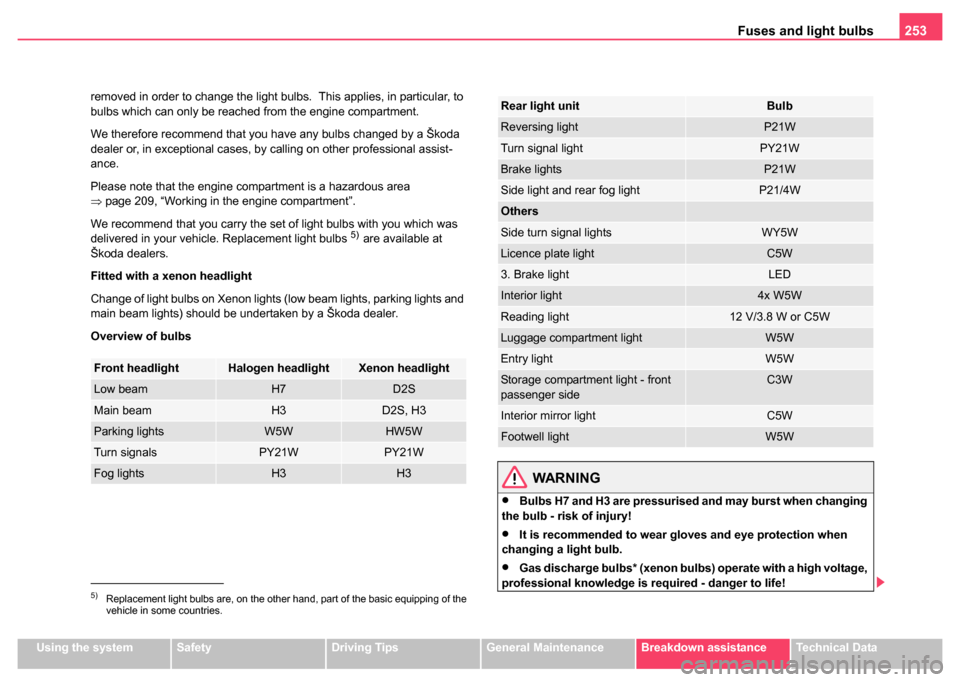
Fuses and light bulbs253
Using the systemSafetyDriving TipsGeneral MaintenanceBreakdown assistanceTechnical Data
removed in order to change the light bulbs. This applies, in particular, to
bulbs which can only be reached from the engine compartment.
We therefore recommend that you have any bulbs changed by a Škoda
dealer or, in exceptional cases, by calling on other professional assist-
ance.
Please note that the engine compartment is a hazardous area
⇒
page 209, “Working in the engine compartment”.
We recommend that you carry the set of light bulbs with you which was
delivered in your vehicle. Replacement light bulbs
5) are available at
Škoda dealers.
Fitted with a xenon headlight
Change of light bulbs on Xenon lights (low beam lights, parking lights and
main beam lights) should be undertaken by a Škoda dealer.
Overview of bulbs
WARNING
•Bulbs H7 and H3 are pressurised and may burst when changing
the bulb - risk of injury!
•It is recommended to wear gloves and eye protection when
changing a light bulb.
•Gas discharge bulbs* (xenon bulbs) operate with a high voltage,
professional knowledge is required - danger to life!
5)Replacement light bulbs are, on the other hand, part of the basic equipping of the
vehicle in some countries.
Front headlightHalogen headlightXenon headlight
Low beamH7D2S
Main beamH3D2S, H3
Parking lightsW5WHW5W
Turn signalsPY21WPY21W
Fog lightsH3H3
Rear light unitBulb
Reversing lightP21W
Turn signal lightPY21W
Brake lightsP21W
Side light and rear fog lightP21/4W
Others
Side turn signal lightsWY5W
Licence plate lightC5W
3. Brake lightLED
Interior light4x W5W
Reading light12 V/3.8 W or C5W
Luggage compartment lightW5W
Entry lightW5W
Storage compartment light - front
passenger sideC3W
Interior mirror lightC5W
Footwell lightW5W
Page 267 of 270
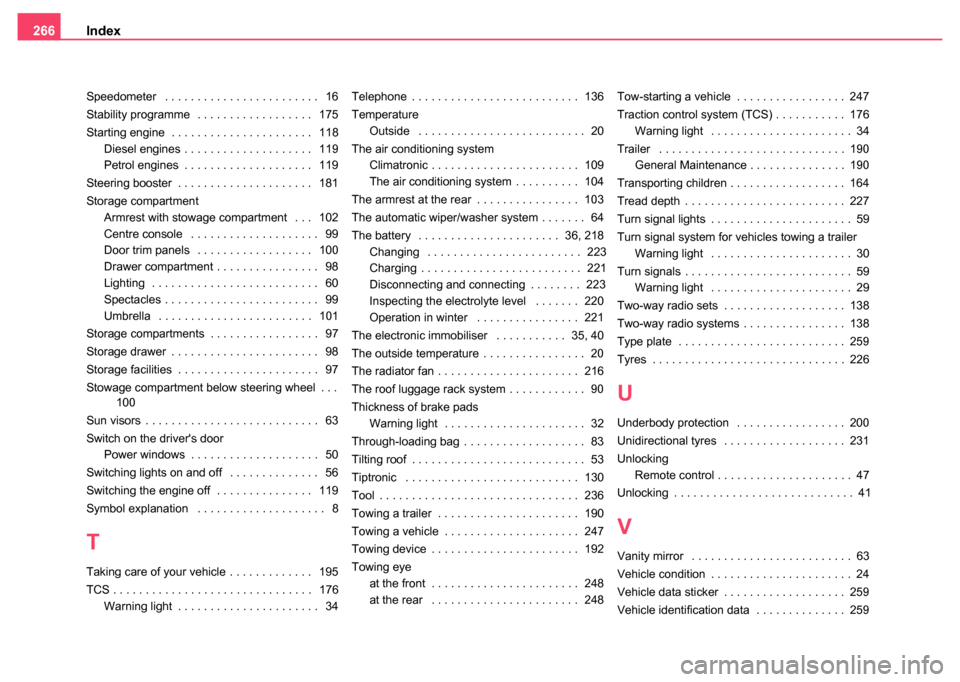
Index
266
Speedometer . . . . . . . . . . . . . . . . . . . . . . . . 16
Stability programme . . . . . . . . . . . . . . . . . . 175
Starting engine . . . . . . . . . . . . . . . . . . . . . . 118
Diesel engines . . . . . . . . . . . . . . . . . . . . 119
Petrol engines . . . . . . . . . . . . . . . . . . . . 119
Steering booster . . . . . . . . . . . . . . . . . . . . . 181
Storage compartment Armrest with stowage compartment . . . 102
Centre console . . . . . . . . . . . . . . . . . . . . 99
Door trim panels . . . . . . . . . . . . . . . . . . 100
Drawer compartment . . . . . . . . . . . . . . . . 98
Lighting . . . . . . . . . . . . . . . . . . . . . . . . . . 60
Spectacles . . . . . . . . . . . . . . . . . . . . . . . . 99
Umbrella . . . . . . . . . . . . . . . . . . . . . . . . 101
Storage compartments . . . . . . . . . . . . . . . . . 97
Storage drawer . . . . . . . . . . . . . . . . . . . . . . . 98
Storage facilities . . . . . . . . . . . . . . . . . . . . . . 97
Stowage compartment below steering wheel . . . 100
Sun visors . . . . . . . . . . . . . . . . . . . . . . . . . . . 63
Switch on the driver's door Power windows . . . . . . . . . . . . . . . . . . . . 50
Switching lights on and off . . . . . . . . . . . . . . 56
Switching the engine off . . . . . . . . . . . . . . . 119
Symbol explanation . . . . . . . . . . . . . . . . . . . . 8
T
Taking care of your vehicle . . . . . . . . . . . . . 195
TCS . . . . . . . . . . . . . . . . . . . . . . . . . . . . . . . 176 Warning light . . . . . . . . . . . . . . . . . . . . . . 34 Telephone . . . . . . . . . . . . . . . . . . . . . . . . . . 136
Temperature
Outside . . . . . . . . . . . . . . . . . . . . . . . . . . 20
The air conditioning system Climatronic . . . . . . . . . . . . . . . . . . . . . . . 109
The air conditioning system . . . . . . . . . . 104
The armrest at the rear . . . . . . . . . . . . . . . . 103
The automatic wiper/washer system . . . . . . . 64
The battery . . . . . . . . . . . . . . . . . . . . . . 36, 218 Changing . . . . . . . . . . . . . . . . . . . . . . . . 223
Charging . . . . . . . . . . . . . . . . . . . . . . . . . 221
Disconnecting and connecting . . . . . . . . 223
Inspecting the electrolyte level . . . . . . . 220
Operation in winter . . . . . . . . . . . . . . . . 221
The electronic immobiliser . . . . . . . . . . . 35, 40
The outside temperature . . . . . . . . . . . . . . . . 20
The radiator fan . . . . . . . . . . . . . . . . . . . . . . 216
The roof luggage rack system . . . . . . . . . . . . 90
Thickness of brake pads Warning light . . . . . . . . . . . . . . . . . . . . . . 32
Through-loading bag . . . . . . . . . . . . . . . . . . . 83
Tilting roof . . . . . . . . . . . . . . . . . . . . . . . . . . . 53
Tiptronic . . . . . . . . . . . . . . . . . . . . . . . . . . . 130
Tool . . . . . . . . . . . . . . . . . . . . . . . . . . . . . . . 236
Towing a trailer . . . . . . . . . . . . . . . . . . . . . . 190
Towing a vehicle . . . . . . . . . . . . . . . . . . . . . 247
Towing device . . . . . . . . . . . . . . . . . . . . . . . 192
Towing eye at the front . . . . . . . . . . . . . . . . . . . . . . . 248
at the rear . . . . . . . . . . . . . . . . . . . . . . . 248 Tow-starting a vehicle . . . . . . . . . . . . . . . . . 247
Traction control system (TCS) . . . . . . . . . . . 176
Warning light . . . . . . . . . . . . . . . . . . . . . . 34
Trailer . . . . . . . . . . . . . . . . . . . . . . . . . . . . . 190 General Maintenance . . . . . . . . . . . . . . . 190
Transporting children . . . . . . . . . . . . . . . . . . 164
Tread depth . . . . . . . . . . . . . . . . . . . . . . . . . 227
Turn signal lights . . . . . . . . . . . . . . . . . . . . . . 59
Turn signal system for vehicles towing a trailer Warning light . . . . . . . . . . . . . . . . . . . . . . 30
Turn signals . . . . . . . . . . . . . . . . . . . . . . . . . . 59 Warning light . . . . . . . . . . . . . . . . . . . . . . 29
Two-way radio sets . . . . . . . . . . . . . . . . . . . 138
Two-way radio systems . . . . . . . . . . . . . . . . 138
Type plate . . . . . . . . . . . . . . . . . . . . . . . . . . 259
Tyres . . . . . . . . . . . . . . . . . . . . . . . . . . . . . . 226
U
Underbody protection . . . . . . . . . . . . . . . . . 200
Unidirectional tyres . . . . . . . . . . . . . . . . . . . 231
Unlocking Remote control . . . . . . . . . . . . . . . . . . . . . 47
Unlocking . . . . . . . . . . . . . . . . . . . . . . . . . . . . 41
V
Vanity mirror . . . . . . . . . . . . . . . . . . . . . . . . . 63
Vehicle condition . . . . . . . . . . . . . . . . . . . . . . 24
Vehicle data sticker . . . . . . . . . . . . . . . . . . . 259
Vehicle identification data . . . . . . . . . . . . . . 259